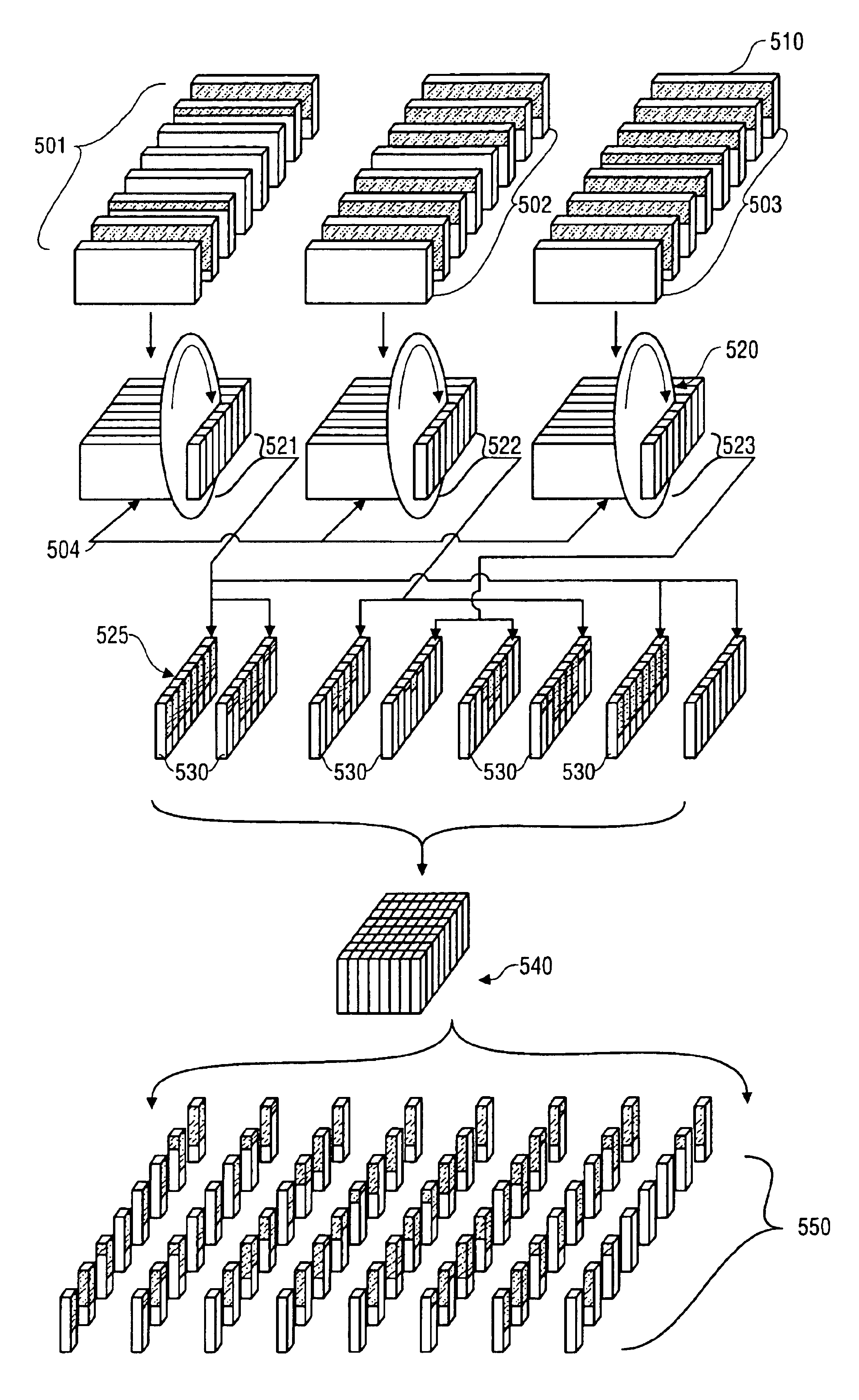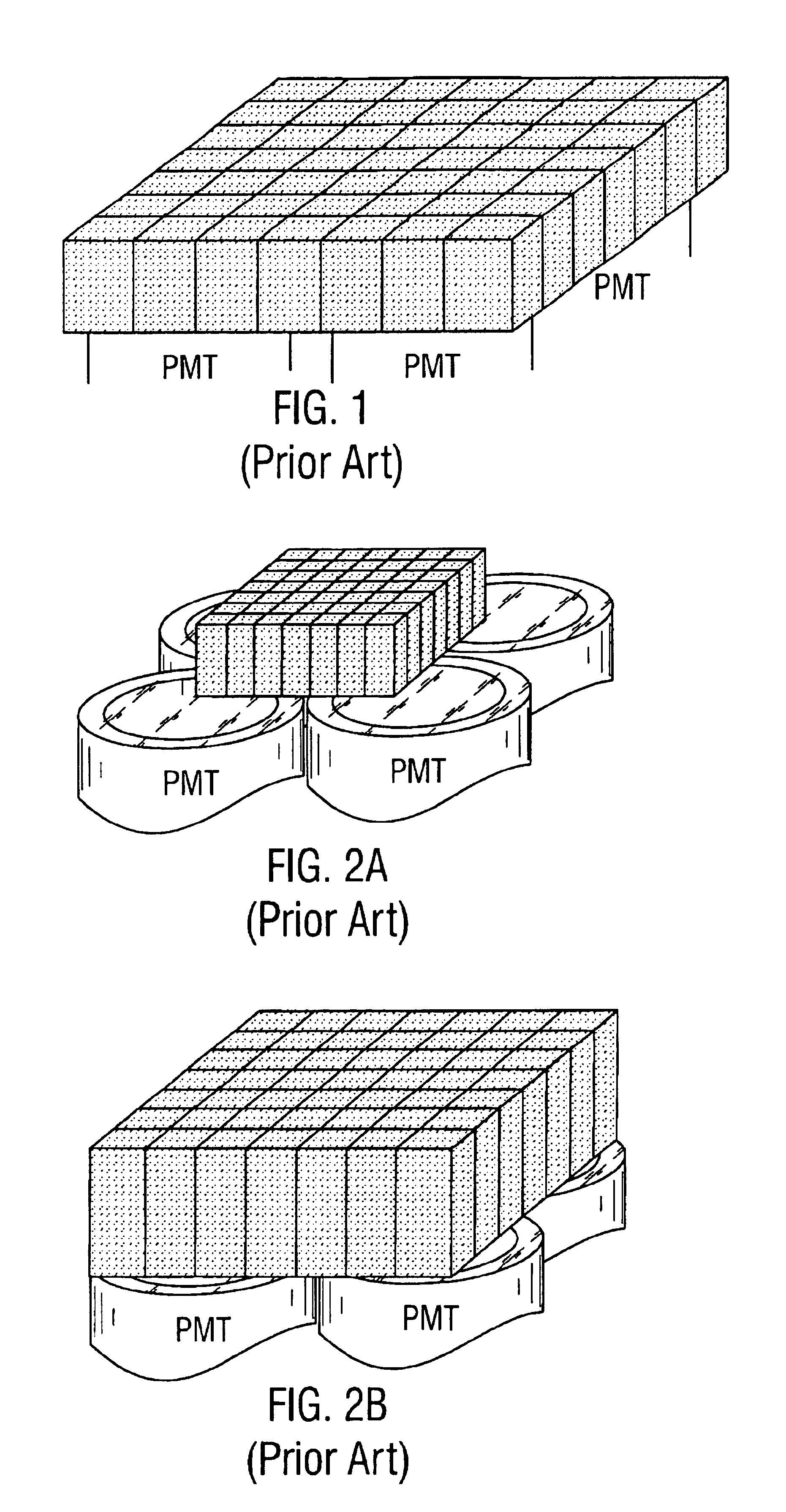Production method for making position-sensitive radiation detector arrays
a radiation detector and production method technology, applied in the field of positron emission tomography (pet), can solve the problems of reducing detection sensitivities, small crystal elements, and large loss of coincidence detection efficiency of very small detectors, and achieves a much simplified production process, improved detection efficiency, and improved detection efficiency.
- Summary
- Abstract
- Description
- Claims
- Application Information
AI Technical Summary
Benefits of technology
Problems solved by technology
Method used
Image
Examples
example 1
[0135]Table 1a and Table 1b show an example of the mask configuration of a 7×7 embodiment of a detector array made by the process of the invention. The information in Tables 1a and 1b are also illustrated in FIG. 28. Scintillation crystal slabs 2100, of a length longer than the intended detector array length, are painted with a number of linear masks 2110 of varying lengths. The crystal slabs are then glued together using an optical glue to form sandwich structures 2106, 2107.
[0136]The sandwiches 2106, 2107 are then cut into slices 2120. Slices from each sandwich type 2106, 2107 are chosen 2121, 2122 and a second set of masks 2130 are painted on the slices 2121, 2122. These slices 2121, 2122 are then glued together to form the final detector array 2150. The resulting detector array 2150, which when broken down into its component pieces, is comprised of individual crystals 2155 that have a first mask 2110 and a second mask 2130 painted on each of two of its facets 2155. When the mask...
example 2
[0140]Table 2a and Table 2b show an example of the mask configuration of a 7×8 embodiment of a detector array made by the process of the invention. The information in Tables 2a and 2b are also illustrated in FIG. 29. Scintillation crystal slabs 2200, of a length longer than the intended detector array length, are painted with a number of linear masks 2210 of varying lengths. The crystal slabs are then glued together using an optical glue to form sandwich structures 2206, 2207, 2208, 2209.
[0141]The sandwiches 2206, 2207, 2208, 2209 are then cut into slices 2220. Slices from each sandwich type 2206, 2207, 2208, 2209 are chosen 2221, 2222, 2223, 2224 and a second set of masks 2230 are painted on the slices 2221, 2222, 2223, 2224. These slices 2221, 2222, 2223, 2224 are then glued together to form the final detector array 2250. The resulting detector array 2250, which when broken down into its component pieces, is comprised of individual crystals 2255 that have a first mask 2210 and a s...
example 3
[0145]Table 3a and Table 3b show an example of the mask configuration of a 8×8 embodiment of a detector array made by the process of the invention. The information in Tables 3a and 3b are also illustrated in FIG. 30. Scintillation crystal slabs 2300, of a length longer than the intended detector array length, are painted with a number of linear masks 2310 of varying lengths. The crystal slabs are then glued together using an optical glue to form sandwich structures 2306, 2307, 2308, 2309.
[0146]The sandwiches 2306, 2307, 2308, 2309 are then cut into slices 2320. Slices from each sandwich type 2306, 2307, 2308, 2309 are chosen 2321, 2322, 2323, 2324 and a second set of masks 2330 are painted on the slices 2321, 2322, 2323, 2324. These slices 2321, 2322, 2323, 2324 are then glued together to form the final detector array 2350. The resulting detector array 2350, which when broken down into its component pieces, is comprised of individual crystals 2355 that have a first mask 2310 and a s...
PUM
 Login to View More
Login to View More Abstract
Description
Claims
Application Information
 Login to View More
Login to View More - R&D
- Intellectual Property
- Life Sciences
- Materials
- Tech Scout
- Unparalleled Data Quality
- Higher Quality Content
- 60% Fewer Hallucinations
Browse by: Latest US Patents, China's latest patents, Technical Efficacy Thesaurus, Application Domain, Technology Topic, Popular Technical Reports.
© 2025 PatSnap. All rights reserved.Legal|Privacy policy|Modern Slavery Act Transparency Statement|Sitemap|About US| Contact US: help@patsnap.com



